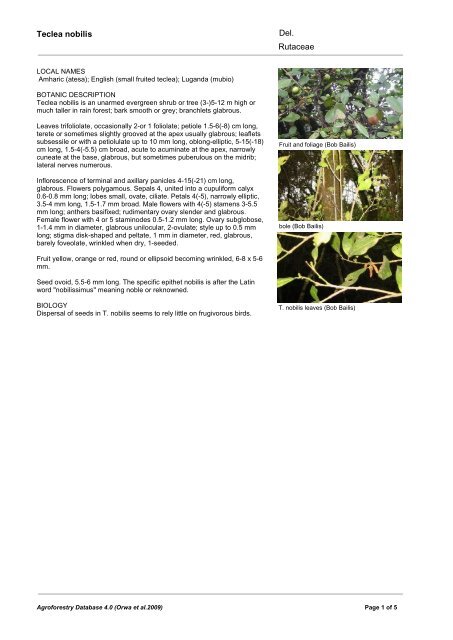Teclea nobilis Rutaceae Del. - World Agroforestry Centre
Teclea nobilis Rutaceae Del. - World Agroforestry Centre
Teclea nobilis Rutaceae Del. - World Agroforestry Centre
You also want an ePaper? Increase the reach of your titles
YUMPU automatically turns print PDFs into web optimized ePapers that Google loves.
<strong>Teclea</strong> <strong>nobilis</strong><br />
LOCAL NAMES<br />
Amharic (atesa); English (small fruited teclea); Luganda (mubio)<br />
BOTANIC DESCRIPTION<br />
<strong>Teclea</strong> <strong>nobilis</strong> is an unarmed evergreen shrub or tree (3-)5-12 m high or<br />
much taller in rain forest; bark smooth or grey; branchlets glabrous.<br />
Leaves trifoliolate, occasionally 2-or 1 foliolate; petiole 1.5-6(-8) cm long,<br />
terete or sometimes slightly grooved at the apex usually glabrous; leaflets<br />
subsessile or with a petiolulate up to 10 mm long, oblong-elliptic, 5-15(-18)<br />
cm long, 1.5-4(-5.5) cm broad, acute to acuminate at the apex, narrowly<br />
cuneate at the base, glabrous, but sometimes puberulous on the midrib;<br />
lateral nerves numerous.<br />
Inflorescence of terminal and axillary panicles 4-15(-21) cm long,<br />
glabrous. Flowers polygamous. Sepals 4, united into a cupuliform calyx<br />
0.6-0.8 mm long; lobes small, ovate, ciliate. Petals 4(-5), narrowly elliptic,<br />
3.5-4 mm long, 1.5-1.7 mm broad. Male flowers with 4(-5) stamens 3-5.5<br />
mm long; anthers basifixed; rudimentary ovary slender and glabrous.<br />
Female flower with 4 or 5 staminodes 0.5-1.2 mm long. Ovary subglobose,<br />
1-1.4 mm in diameter, glabrous unilocular, 2-ovulate; style up to 0.5 mm<br />
long; stigma disk-shaped and peltate, 1 mm in diameter, red, glabrous,<br />
barely foveolate, wrinkled when dry, 1-seeded.<br />
Fruit yellow, orange or red, round or ellipsoid becoming wrinkled, 6-8 x 5-6<br />
mm.<br />
Seed ovoid, 5.5-6 mm long. The specific epithet <strong>nobilis</strong> is after the Latin<br />
word "<strong>nobilis</strong>simus" meaning noble or reknowned.<br />
BIOLOGY<br />
Dispersal of seeds in T. <strong>nobilis</strong> seems to rely little on frugivorous birds.<br />
<strong>Agroforestry</strong> Database 4.0 (Orwa et al.2009)<br />
<strong>Del</strong>.<br />
<strong>Rutaceae</strong><br />
Fruit and foliage (Bob Bailis)<br />
bole (Bob Bailis)<br />
T. <strong>nobilis</strong> leaves (Bob Bailis)<br />
Page 1 of 5
<strong>Teclea</strong> <strong>nobilis</strong><br />
<strong>Del</strong>.<br />
<strong>Rutaceae</strong><br />
ECOLOGY<br />
A large tree found in evergreen forest, riverine forest and woodland. Commonly associated with Podocarpus and<br />
Juniperus. In Uganda it grows in colonizing forests, thickets, forest edges and mixed forest from lowland to lower<br />
montane areas.<br />
BIOPHYSICAL LIMITS<br />
Altitude: 900-2 600 m<br />
Mean annual rainfall: 1 200-2 500 mm<br />
Mean annual temperature: 18-26 deg.C<br />
DOCUMENTED SPECIES DISTRIBUTION<br />
Native:<br />
Exotic:<br />
Ethiopia, Kenya, Tanzania, Uganda<br />
Native range<br />
Exotic range<br />
The map above shows countries where the species has been planted. It does neither<br />
suggest that the species can be planted in every ecological zone within that country,<br />
nor that the species can not be planted in other countries than those depicted. Since<br />
some tree species are invasive, you need to follow biosafety procedures that apply to<br />
your planting site.<br />
<strong>Agroforestry</strong> Database 4.0 (Orwa et al.2009)<br />
Page 2 of 5
<strong>Teclea</strong> <strong>nobilis</strong><br />
PRODUCTS<br />
Food: The fruit is edible.<br />
The map above shows countries where the species has been planted. It does neither<br />
suggest that the species can be planted in every ecological zone within that country,<br />
nor that the species can not be planted in other countries than those depicted. Since<br />
<strong>Del</strong>.<br />
some tree species are invasive, you need to follow biosafety procedures that apply to<br />
your planting site.<br />
Apiculture: The fragrant flowers are a source of nectar and pollen for bees.<br />
Fuel: Provides good fuelwood.<br />
<strong>Rutaceae</strong><br />
Timber: The wood is used to make bows, tool handles, barkcloth mallets, clubs and walking sticks. Poles obtained from<br />
the tree are used for house construction. The wood is tough, strong, durable predisposing it to overexploitation in its<br />
native range.<br />
Essential oil:<br />
Medicine: The leaf or root decoction mixed with honey is used against pneumonia in Kenya. The roots are used as an<br />
anthelminthic. The steam inhalation of the leaves reportedly cures fever.<br />
SERVICES<br />
Shade or shelter: This tree provides excellent shade.<br />
Soil improver: The leaf litter enriches underlying soil.<br />
Boundary or barrier or support: Poles obtained from the tree are used for fencing and construction.<br />
<strong>Agroforestry</strong> Database 4.0 (Orwa et al.2009)<br />
Page 3 of 5
<strong>Teclea</strong> <strong>nobilis</strong><br />
TREE MANAGEMENT<br />
A moderate to slow growing tree. Can be managed by coppicing and pollarding.<br />
<strong>Del</strong>.<br />
<strong>Rutaceae</strong><br />
GERMPLASM MANAGEMENT<br />
T. <strong>nobilis</strong> is not a prolific seeder, has about 20 000 seeds/kg. Germination rates and seed viability are low.<br />
<strong>Agroforestry</strong> Database 4.0 (Orwa et al.2009)<br />
Page 4 of 5
<strong>Teclea</strong> <strong>nobilis</strong><br />
<strong>Del</strong>.<br />
<strong>Rutaceae</strong><br />
FURTHER READNG<br />
Chapman CA and Chapman LJ. 1995. Survival without dispersers: seedling recruitment under parents. Conservation<br />
Biology. 9(3): 675-678.<br />
Katende AB et al. 1995. Useful trees and shrubs for Uganda. Identification, Propagation and Management for<br />
Agricultural and Pastoral Communities. Regional Soil Conservation Unit (RSCU), Swedish International Development<br />
Authority (SIDA).<br />
Kokwaro JO. 1976. Medicinal plants of East Africa. East African Literature Bureau.<br />
Kokwaro JO. 1982. <strong>Rutaceae</strong>. In: Flora of Tropical East Africa. AA Balkema, Rotterdam.<br />
SUGGESTED CITATION<br />
Orwa C, A Mutua, Kindt R , Jamnadass R, S Anthony. 2009 Agroforestree Database:a tree reference and selection guide<br />
version 4.0 (http://www.worldagroforestry.org/sites/treedbs/treedatabases.asp)<br />
<strong>Agroforestry</strong> Database 4.0 (Orwa et al.2009)<br />
Page 5 of 5

















